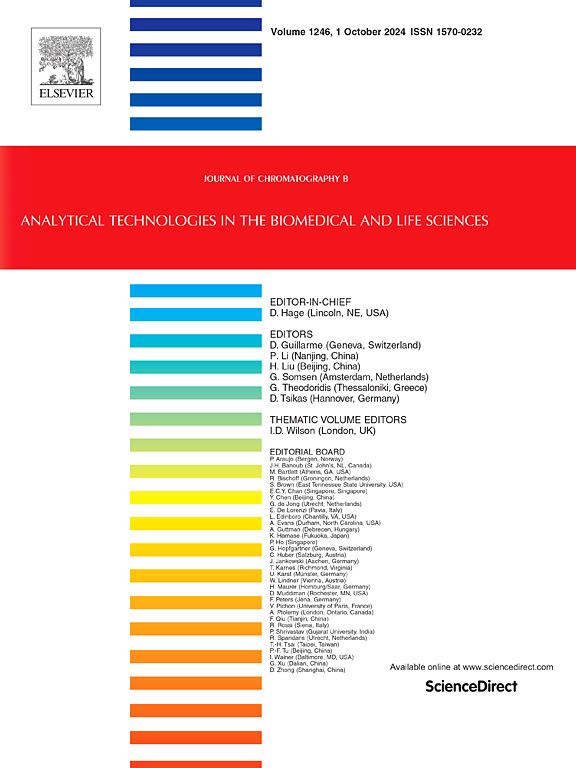基于机制模型的双特异性抗体-同型二聚体阳离子交换色谱分离工艺的建立。
IF 2.8
3区 医学
Q2 BIOCHEMICAL RESEARCH METHODS
引用次数: 0
摘要
在重组生产igg样双特异性抗体(bsAbs)的过程中,同源二聚体的形成是一个主要的纯化挑战,它源于不平衡的链表达和不正确的链配对。尽管阳离子交换色谱法在处理这种基于电荷的分离方面具有实用性,但由于控制蛋白质-树脂相互作用的多个参数(例如盐浓度、负载条件)的相互作用,其发展仍然具有内在的复杂性。对于bsAb和同型二聚体的分离,采用阳离子交换色谱的机理模型来预测洗脱行为,从而优化工艺条件。比较了扩展Langmuir和空间质量作用(SMA)两种吸附模型的标定过程和验证结果。后者被选择用于工艺优化,因为它简化了校准工作流程,能够有效地预测洗脱行为。确定最佳洗脱液浓度为120 mM NaCl。在此条件下,bsAb的产率达到96.4%,同型二聚体1的含量由26.4%降至0.5%。产率和杂质含量的预测结果与实验结果的偏差均在1.5%以内,表明所建立的色谱机理模型具有较高的准确性和可靠性,可指导工艺优化。本文章由计算机程序翻译,如有差异,请以英文原文为准。
Development of a bispecific antibody-homodimer separation process by cation exchange chromatography based on mechanistic modelling
During the recombinant production of IgG-like bispecific antibodies (bsAbs), homodimer formation, which stems from unbalanced chain expression and incorrect chain pairing, presents a major purification challenge. Despite its utility in addressing such charge-based separations, the development of cation exchange chromatography processes remains inherently complex due to the interplay of multiple parameters (e.g., salt concentration, loading conditions) that govern protein-resin interactions. For the separation of bsAb and homodimer, a mechanistic model of cation exchange chromatography was employed to predict the elution behavior, thereby facilitating the optimization of process conditions. The calibration processes and validation results of the extended Langmuir and steric mass action (SMA) two adsorption models were compared. The latter was selected for process optimization due to its streamlined calibration workflow, enabling efficient prediction of elution behavior. The optimal eluent concentration was determined to be 120 mM NaCl. Under this condition, the target bsAb yield reached 96.4 %, and homodimer 1 content was reduced from 26.4 % to 0.5 %. Deviations between the predicted and experimental results for both yield and impurity content were confined within 1.5 %, demonstrating the high accuracy and reliability of the established chromatographic mechanistic model for guiding process optimization.
求助全文
通过发布文献求助,成功后即可免费获取论文全文。
去求助
来源期刊

Journal of Chromatography B
医学-分析化学
CiteScore
5.60
自引率
3.30%
发文量
306
审稿时长
44 days
期刊介绍:
The Journal of Chromatography B publishes papers on developments in separation science relevant to biology and biomedical research including both fundamental advances and applications. Analytical techniques which may be considered include the various facets of chromatography, electrophoresis and related methods, affinity and immunoaffinity-based methodologies, hyphenated and other multi-dimensional techniques, and microanalytical approaches. The journal also considers articles reporting developments in sample preparation, detection techniques including mass spectrometry, and data handling and analysis.
Developments related to preparative separations for the isolation and purification of components of biological systems may be published, including chromatographic and electrophoretic methods, affinity separations, field flow fractionation and other preparative approaches.
Applications to the analysis of biological systems and samples will be considered when the analytical science contains a significant element of novelty, e.g. a new approach to the separation of a compound, novel combination of analytical techniques, or significantly improved analytical performance.
 求助内容:
求助内容: 应助结果提醒方式:
应助结果提醒方式:


